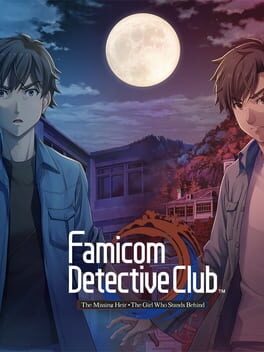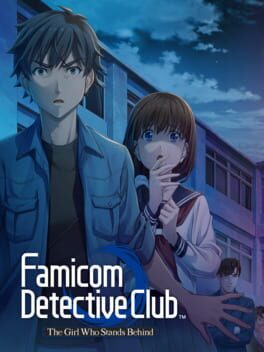

Famicom Detective Club: The Two-Case Collection
released on May 14, 2021
A bundle of two Famicom Detective Club remakes released on Nintendo Switch.
Also in series
Reviews View More
In 1983, Yuuji Horii – the future creator of Dragon Quest – made the first game of a trilogy that was to become the foundation of an entire genre: Portopia Renzoku Satsujin Jiken. Then a new employee of Enix, his projects led him to create games for microcomputers and the release of Deadline in the West made him want to make a detective story. In 1985, the renaissance of console video games with the Famicom led Enix to bring Portopia to the market. The title then gained popular success, not least because of a radio broadcast where Takeshi Kitano, playing the title, exclaimed 「犯人はヤス!」("The culprit is Yasu!"), which became a meme across Japan. This publicity undoubtedly helped establish Portopia as the spearhead of Japanese text adventure games. In particular, it gave birth to and solidified a whole tradition of investigative games in a realistic setting. In 1988, Nintendo tried its hand at the genre, with the figure of Yoshio Sakamoto, then known as the creator of Metroid. Famicom Tantei Club: Kieta Koukeisha was released, which also imposed its own narrative rules, founding an important part of Japanese fiction.
This title puts us in the shoes of a young high school student who has amnesia after falling off a cliff. He is taken in by Amachi, who offers him to go back to the cliff to regain his memories. We then meet Ayumi Tachibana, colleague at the Utsugi detective agency, who tells us that we were investigating a case in a small village. A series of murders follows, which must be solved while trying to recover our memory. It is particularly amusing to see how much the title draws from other works and departs from what Nintendo is used to doing: if the reference to Portopia is obvious, as the plot and the resolution are similar, Sakamoto adds a mystical, almost supernatural tinge to it, thanks to his viewings of Dario Argento's films. Very classical in its construction, the investigation can only remind one of the mysteries of the Golden Age of Detective Fiction. It is thus obvious that The Missing Heir draws heavily from the works of Seishi Yokomizo, in particular from two of his post-war works, Yatsuhakamura (1949-1951) and Inugamike no Ichizoku (1950-1951). These include the idea of a series of murders and the aesthetics of small country villages, allowing for supernatural elements and the feeding of superstition, as found in Dickson Carr.
Perhaps even more important to the history of Japanese pop-culture is the second title, Ushiro ni Tatsu Shoujo, released in 1989 and often considered the better title of the two. It is a prequel to The Missing Heir, which places us two years in the past, when Ayumi Tachibana is a freshly minted high school student. One day, the corpse of one of her friends, Yoko Kojima, is discovered in a river. Our protagonist decides to investigate and soon learns that the victim was investigating a mystery in her high school: fifteen years ago, a girl disappeared and her ghost is haunting the school buildings. Things get more complicated when it is understood that the current case is linked to an old murder. Nevertheless, the mystery is more condensed than in the first title: no complex family history here, but a few people and a school as a general setting.
It is striking to see how the games are anchored in their time. The aesthetic of The Missing Heir is reminiscent of Japan, still in its very positive economic growth, allowing for family conglomerates. The representation of high school in The Girl Who Stands Behind is more reminiscent of 1980s manga: Hitomi's hairstyle is reminiscent of the iconic haircuts of Be-Bop High School (1983) and the little romances can be reminiscent of Miyuki (1980), or even Kimagure Orange Road (1984). In the other direction, Famicom Tantei Club paves the way for many works that take up the idea of the high school detective. The idea existed before – Robert Arthur Jr.'s The Three Investigators (1964), if you magnify the line – but there is no denying that Famicom Tantei Club sets a new standard for the genre. In particular, Kindaichi shounen no jikenbo (1992) is completely inspired by it.
Iconic titles, then. Major inspiration, no doubt. Nevertheless, like almost all Japanese adventure games, Famicom Tantei Club was never taken outside the archipelago. There was a remake on Super Famicom, but without a Western localisation. The first images of the Switch remakes were revealed in the September 2019 Nintendo Direct. A postponement of the release to 2021 was announced in October, suggesting a Western localisation. This is how we can enjoy these games in their "final" version.
The remakes follow the logic of the Super Famicom ports: that is to say, the story and the general flow of the game are maintained, but the graphics, sound design and quality of life options (e.g. the notebook, the open questions or the colours to facilitate menuing) are significantly improved. The prolific development studio Mages was put in charge of this update and one cannot argue that the result is sublime, possibly at the top of what Japanese textual games/visual novels offer. The backgrounds are rich and blend well with the elegantly semi-animated character sprites. The sound design is effective and the new instrumentation is particularly pleasant, especially since it is still possible to use the original soundtrack or the one from the Super Famicom. Finally, the full dubbing is led by a high-flying cast, since it brings back Yuko Minaguchi (Nadeshiko Kinomoto, Sailor Saturn) for Ayumi Tachibana, already dubbing for the Satellaview opus, but also Megumi Ogata (Shinji Ikari), Atsuko Tanaka (Motoko Kusanagi), Tomokazu Sugita (Kyon) or the well known Shigeru Chiba.
Nevertheless, the archaisms of the Famicom era remain in the game design. The game works with a series of triggers, so that nothing will happen until such and such an action has been done, for example asking a person a third time about a particular subject, using the function to think or interacting with an element of the scenery. The pace suffers greatly, especially towards the end of The Missing Heir, which lacks momentum. In The Girl Who Stands Behind, the pace was already better articulated and only a few cryptic interactions can be a problem, not unlike the obtuse puzzles of Western point&clicks. While this may put some people off, it is also a certain aesthetic of preservation. As I pointed out above, Famicom Tantei Club is a dilogy of its time, and it's completely understandable – especially as we know Nintendo's stance on the subject – to decide to keep the game as is, without trying to change it more than necessary. Especially in 2021, the atmosphere of both titles really does appeal nostalgically to a certain representation of Japan: archaic gameplay similarly appeals to what Japanese adventure gaming was like in the 1980s – of course, some might argue that Hokkaido Rensa Satsujin: Ohotsuku ni Kiyu (1984), the sequel to Portopia, was better done in these aspects.
While this is a valuable object for the preservation of the medium, one cannot help but be dubious about the price. Each title takes about eight hours to complete, even though the experience is very enjoyable. 60€ thus seems particularly expensive, when it is the only opportunity to play the games legally – there is a fan translation for the second title, when the West became aware of the series, via Ayumi Tachibana's trophy in Super Smash Bros. Melee –, more than thirty years after their original release. With the proliferation of remakes in recent years, keeping prices so high is problematic, especially in cases like Super Mario 3D All-Stars, where improvements are almost non-existent, as they are very basic roms. This financial argument raises the question of what is and isn't worth preserving, which shouldn't be a criteria. Unfortunately, anything created for the Satellaview is unlikely to be revived and the original experience is more or less lost, as it was an extension of the Super Famicom, connected to the St. GIGA TV station, which transmitted news, features and updated the games. However, no real content was officially preserved, including the well-received BS Zelda no densetsu.
Either way, Famicom Detective Club is a rich addition to the Switch's catalogue, helping to revive a genre for a new generation of players. Western audiences know little about the Japanese adventure game, as it has been supplanted by visual novels. As the overwhelming majority of PC-98 games have not been localised, it is a genre that has fallen into obscurity. But the new interest in the Ace Attorney franchise among the general public with the re-release of the trilogy for modern platforms or the success of Danganronpa among the otaku public has democratised the investigation game genre. This has led to the unexpected localisation of Dai Gyakuten Saiban, which has been requested since 2015. The future is therefore bright and we can only hope to see more titles like these, and why not a sequel to Famicom Detective Club!
This title puts us in the shoes of a young high school student who has amnesia after falling off a cliff. He is taken in by Amachi, who offers him to go back to the cliff to regain his memories. We then meet Ayumi Tachibana, colleague at the Utsugi detective agency, who tells us that we were investigating a case in a small village. A series of murders follows, which must be solved while trying to recover our memory. It is particularly amusing to see how much the title draws from other works and departs from what Nintendo is used to doing: if the reference to Portopia is obvious, as the plot and the resolution are similar, Sakamoto adds a mystical, almost supernatural tinge to it, thanks to his viewings of Dario Argento's films. Very classical in its construction, the investigation can only remind one of the mysteries of the Golden Age of Detective Fiction. It is thus obvious that The Missing Heir draws heavily from the works of Seishi Yokomizo, in particular from two of his post-war works, Yatsuhakamura (1949-1951) and Inugamike no Ichizoku (1950-1951). These include the idea of a series of murders and the aesthetics of small country villages, allowing for supernatural elements and the feeding of superstition, as found in Dickson Carr.
Perhaps even more important to the history of Japanese pop-culture is the second title, Ushiro ni Tatsu Shoujo, released in 1989 and often considered the better title of the two. It is a prequel to The Missing Heir, which places us two years in the past, when Ayumi Tachibana is a freshly minted high school student. One day, the corpse of one of her friends, Yoko Kojima, is discovered in a river. Our protagonist decides to investigate and soon learns that the victim was investigating a mystery in her high school: fifteen years ago, a girl disappeared and her ghost is haunting the school buildings. Things get more complicated when it is understood that the current case is linked to an old murder. Nevertheless, the mystery is more condensed than in the first title: no complex family history here, but a few people and a school as a general setting.
It is striking to see how the games are anchored in their time. The aesthetic of The Missing Heir is reminiscent of Japan, still in its very positive economic growth, allowing for family conglomerates. The representation of high school in The Girl Who Stands Behind is more reminiscent of 1980s manga: Hitomi's hairstyle is reminiscent of the iconic haircuts of Be-Bop High School (1983) and the little romances can be reminiscent of Miyuki (1980), or even Kimagure Orange Road (1984). In the other direction, Famicom Tantei Club paves the way for many works that take up the idea of the high school detective. The idea existed before – Robert Arthur Jr.'s The Three Investigators (1964), if you magnify the line – but there is no denying that Famicom Tantei Club sets a new standard for the genre. In particular, Kindaichi shounen no jikenbo (1992) is completely inspired by it.
Iconic titles, then. Major inspiration, no doubt. Nevertheless, like almost all Japanese adventure games, Famicom Tantei Club was never taken outside the archipelago. There was a remake on Super Famicom, but without a Western localisation. The first images of the Switch remakes were revealed in the September 2019 Nintendo Direct. A postponement of the release to 2021 was announced in October, suggesting a Western localisation. This is how we can enjoy these games in their "final" version.
The remakes follow the logic of the Super Famicom ports: that is to say, the story and the general flow of the game are maintained, but the graphics, sound design and quality of life options (e.g. the notebook, the open questions or the colours to facilitate menuing) are significantly improved. The prolific development studio Mages was put in charge of this update and one cannot argue that the result is sublime, possibly at the top of what Japanese textual games/visual novels offer. The backgrounds are rich and blend well with the elegantly semi-animated character sprites. The sound design is effective and the new instrumentation is particularly pleasant, especially since it is still possible to use the original soundtrack or the one from the Super Famicom. Finally, the full dubbing is led by a high-flying cast, since it brings back Yuko Minaguchi (Nadeshiko Kinomoto, Sailor Saturn) for Ayumi Tachibana, already dubbing for the Satellaview opus, but also Megumi Ogata (Shinji Ikari), Atsuko Tanaka (Motoko Kusanagi), Tomokazu Sugita (Kyon) or the well known Shigeru Chiba.
Nevertheless, the archaisms of the Famicom era remain in the game design. The game works with a series of triggers, so that nothing will happen until such and such an action has been done, for example asking a person a third time about a particular subject, using the function to think or interacting with an element of the scenery. The pace suffers greatly, especially towards the end of The Missing Heir, which lacks momentum. In The Girl Who Stands Behind, the pace was already better articulated and only a few cryptic interactions can be a problem, not unlike the obtuse puzzles of Western point&clicks. While this may put some people off, it is also a certain aesthetic of preservation. As I pointed out above, Famicom Tantei Club is a dilogy of its time, and it's completely understandable – especially as we know Nintendo's stance on the subject – to decide to keep the game as is, without trying to change it more than necessary. Especially in 2021, the atmosphere of both titles really does appeal nostalgically to a certain representation of Japan: archaic gameplay similarly appeals to what Japanese adventure gaming was like in the 1980s – of course, some might argue that Hokkaido Rensa Satsujin: Ohotsuku ni Kiyu (1984), the sequel to Portopia, was better done in these aspects.
While this is a valuable object for the preservation of the medium, one cannot help but be dubious about the price. Each title takes about eight hours to complete, even though the experience is very enjoyable. 60€ thus seems particularly expensive, when it is the only opportunity to play the games legally – there is a fan translation for the second title, when the West became aware of the series, via Ayumi Tachibana's trophy in Super Smash Bros. Melee –, more than thirty years after their original release. With the proliferation of remakes in recent years, keeping prices so high is problematic, especially in cases like Super Mario 3D All-Stars, where improvements are almost non-existent, as they are very basic roms. This financial argument raises the question of what is and isn't worth preserving, which shouldn't be a criteria. Unfortunately, anything created for the Satellaview is unlikely to be revived and the original experience is more or less lost, as it was an extension of the Super Famicom, connected to the St. GIGA TV station, which transmitted news, features and updated the games. However, no real content was officially preserved, including the well-received BS Zelda no densetsu.
Either way, Famicom Detective Club is a rich addition to the Switch's catalogue, helping to revive a genre for a new generation of players. Western audiences know little about the Japanese adventure game, as it has been supplanted by visual novels. As the overwhelming majority of PC-98 games have not been localised, it is a genre that has fallen into obscurity. But the new interest in the Ace Attorney franchise among the general public with the re-release of the trilogy for modern platforms or the success of Danganronpa among the otaku public has democratised the investigation game genre. This has led to the unexpected localisation of Dai Gyakuten Saiban, which has been requested since 2015. The future is therefore bright and we can only hope to see more titles like these, and why not a sequel to Famicom Detective Club!
Thank you, Mr. Sakamoto!
If you're really into visual novels and detective games, Famicom Detective Club is exactly what you want. It kept me going until the very end both times, and had me speculating right along with the protagonist. This game definitely deserves the reputation it has, and if you like anything like Ace Attorney or Danganronpa this is worth picking up.
If it's not your kinda thing I wouldn't recommend it, of course. But it's a prime example as to why this genre works. I expected it to be shorter, but it was the perfect length.
The presentation is basically an interactive anime, and I'd love to see it adapted to that medium, or even another game. It's never too late for a 3rd chapter to the Famicom Detective Club.
If you're really into visual novels and detective games, Famicom Detective Club is exactly what you want. It kept me going until the very end both times, and had me speculating right along with the protagonist. This game definitely deserves the reputation it has, and if you like anything like Ace Attorney or Danganronpa this is worth picking up.
If it's not your kinda thing I wouldn't recommend it, of course. But it's a prime example as to why this genre works. I expected it to be shorter, but it was the perfect length.
The presentation is basically an interactive anime, and I'd love to see it adapted to that medium, or even another game. It's never too late for a 3rd chapter to the Famicom Detective Club.
Only finished The Missing Heir, will update once I‘ve played The Girl Who Stands Behind
———
Very exhausting to play, as the gameplay boils down to trial and error-ing all dialog options and switching back and forth between locations until the game finally decides to let you continue.
Examining your surroundings is pretty much useless, apart from the few times where you need to pick up a glittering object.
There are almost no puzzles to solve (maybe... one or two?) and the first half of the story felt like I was barely making progress.
Still, in the last three or four hours the story got me hooked somehow, even if it was predictable.
———
Very exhausting to play, as the gameplay boils down to trial and error-ing all dialog options and switching back and forth between locations until the game finally decides to let you continue.
Examining your surroundings is pretty much useless, apart from the few times where you need to pick up a glittering object.
There are almost no puzzles to solve (maybe... one or two?) and the first half of the story felt like I was barely making progress.
Still, in the last three or four hours the story got me hooked somehow, even if it was predictable.





